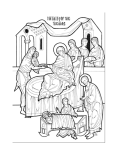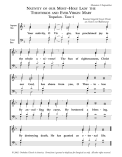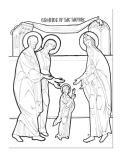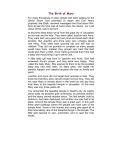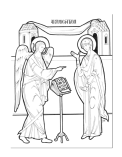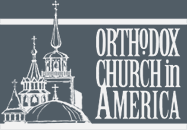The Theotokos
Introduction (Ages 4-6)
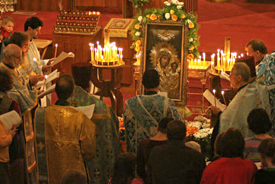 Christianity is unique in giving the world a true understanding of God as having humbled Himself, in the Person of Jesus Christ, so that He could share and redeem our life. No other faith teaches, in the same way that Christianity does, that God would "demean" Himself by becoming Man. No other faith gives humankind the joyful news that by undergoing and overcoming an excruciating death, Jesus Christ destroyed death's power over us forever.
Christianity is unique in giving the world a true understanding of God as having humbled Himself, in the Person of Jesus Christ, so that He could share and redeem our life. No other faith teaches, in the same way that Christianity does, that God would "demean" Himself by becoming Man. No other faith gives humankind the joyful news that by undergoing and overcoming an excruciating death, Jesus Christ destroyed death's power over us forever.
But our loving God is so careful of our freedom that He did not come to us in a flashy and overwhelming miracle. He sought human cooperation, and that came in the person of a young woman who lived in worldly circumstances of poverty and powerlessness. The young woman faced the brutal possibility that she would be stoned to death for fornication. Her willingness to face that hard reality, to cooperate with God's will, came from her faith.
This unit is intended to help students see why the Orthodox Church honors that young woman, the Holy Virgin Mary and Theotokos. She had faith that all would be as the angel Gabriel promised her it would. So she said to him, "Let it be." With those words, she consented to God's plan for our salvation. How could we not honor her, above all other saints, when it is her co-operation that puts God's plan into action?
That brings us to one of several things we want students to know: Mary was not forced or obligated to consent to God's plan. She could have said "no." She is our model, born with free will as we all are, of one who chose to say "yes" to God, as we can also do.
 We also want students to be aware of the reason for the Church's emphasis on Mary's ever-virginity. (This applies mostly to older students, who are dealing with questions of sexuality in their own lives.) The translation of the Hymn to the Theotokos ("More honorable...") most commonly used in our OCA churches states: "Without defilement you gave birth to God the Word; true Theotokos, we magnify you." Students will be learning this hymn as part of the unit, so it is important that they understand its meaning properly. The word "defilement" is not the only way to translate the original words, and should not lead students to think that normal human sexual intercourse is considered "dirty" or "defiling" by the Church. The word only points to the miracle of this birth: Jesus was born without a human father, by the power of God, while still taking flesh from His mother. This was the divine/human birth of the divine/human Son of God.
We also want students to be aware of the reason for the Church's emphasis on Mary's ever-virginity. (This applies mostly to older students, who are dealing with questions of sexuality in their own lives.) The translation of the Hymn to the Theotokos ("More honorable...") most commonly used in our OCA churches states: "Without defilement you gave birth to God the Word; true Theotokos, we magnify you." Students will be learning this hymn as part of the unit, so it is important that they understand its meaning properly. The word "defilement" is not the only way to translate the original words, and should not lead students to think that normal human sexual intercourse is considered "dirty" or "defiling" by the Church. The word only points to the miracle of this birth: Jesus was born without a human father, by the power of God, while still taking flesh from His mother. This was the divine/human birth of the divine/human Son of God.
Overall Objectives of the Unit
- Understand the importance of the Theotokos as an intercessor in our relationship with Jesus Christ and
- Understand the importance of the Theotokos as a model for us today.
Keeping these two objectives in mind can help us, as teachers, focus on the important fact that every worship service in the Orthodox Church contains one or more references to Mary. She also is given the the title of honor, established at the Third Ecumenical Council in Ephesus (451), of "Theotokos" or Birthgiver of God.
Fr. Alexander Schmemann describes Mary's place in our faith in this way:
The veneration of the Virgin Mary is a necessary component of our faith: The image of the Virgin Mary, the Virgin Mother, stands [as] the image of infinite humility and purity, filled with beauty and strength; the image of love and the victory of love. The Virgin Mary, the All-Pure Mother demands nothing and receives everything. She pursues nothing and possesses all. In the image of the Virgin Mary, we find compassion, tender-heartedness, care, trust, humility. We call her Our Lady and the Queen of Heaven and Earth, and yet she calls herself "the hand-maid of the Lord." .. Christ said, 'Do not be anxious. Seek first the Kingdom of God' (see Mt 6:33). Beholding this woman - Virgin Mother, Intercessor - we begin to sense, to know not with our mind, but with our heart, what it means to seek the Kingdom, to find it, and to live by it.THE VIRGIN MARY: THE CELEBRATION OF FAITH
by Alexander Schmemann, pages 21 - 22.
How the Unit is Arranged
The unit is comprised of five lessons of about 45-60 minutes each. The first four each deal with a feast of Mary, and are presented in the order in which those feasts come in the Church calendar. This order also corresponds to the chronology of Mary's life. It's suggested that the Troparion and Kontakion for each feast be used as opening and closing prayers, respectively, of the sessions in which they are covered. The fifth session deals with five icons of the Theotokos.
The lessons have each been written on five levels: ages 4-6, ages 7-9, ages 10-12, ages 13-17, and ages 18+. The ages 13-17 may be split into two groups, older and younger, for discussions. For each level in a session, there is a lesson plan. All the lesson plans contain the following parts:
- The lesson theme
- The age group for which the session is intended
- The lesson title
- A series of objectives
Objectives are things that the students should be able to do as a result of the session. Objectives should be things the teacher can measure. Objectives contain verbs such as define, name, list, explain, tell, and other measurable actions. Through questions and discussion, teachers can ascertain whether students are able to fulfill these objectives. If they are not able to do so, teachers will know that review or repetition are necessary. - Resources and Materials Needed.
These are the various materials the teacher will need to teach the session and meet the objectives. These include icons, art, photos, liturgical texts, Bible stories and passages, and craft materials that will be part of the session. - Procedure This is a step-by step outline of how the session should go.
It is truly meet to bless you, O Theotokos,
ever blessed and most pure, and the Mother of our God.
More honorable than the Cherubim,
and more glorious beyond compare than the Seraphim,
without defilement you gave birth to God the Word.
True Theotokos, we magnify you!
The Nativity of the Theotokos (September 8) (Ages 4-6)
Overview
Mary's humanity and God's love
- Mary's humanity and God's love
Objectives
By the end of this Lesson, learners should be able to:- Identify the feast by name and/or match it to the Icon(s) of the feast
- Identify key persons (or events) shown in the festal icon
- Tell the story of the event of the Feast, with the aid of the icon, the festal Troparion and/or Kontakion, crafts and/or activities
- Sing the Troparion of the Feast (a Psalm verse or Prokeimenon) and/or the Hymn to the Theotokos: "It is Truly Meet"
Materials
- Festal Icon of the Nativity of the Theotokos
- Small (4”x5”) color prints of the festal icon
- Black & white line drawing of the festal icon
- Festal Troparion & Kontakion
- Available recordings of the Festal Troparion & Kontakion and any equipment needed to play them
- Story of the Nativity of the Theotokos
- A folder or large 9”x12” envelope for each child
- A children’s dictionary to use in explaining difficult words from the hymns
- Crayons, colored pencils or markers
- Teacher Background Information
Resources
Required Resources Optional Resources
Procedure
| 1 |
Opening Prayer |
Troparion (Tone 4) Explain words like Nativity (birth), Cherubim and Seraphim (angels of God), righteousness (goodness, doing what’s right, etc.) |
| 2 |
Story of Mary's Birth |
Explain that you will now read a story that tells about the prayer that you just sang. Tell the students the story of Joachim and Anna, and the birth of their daughter, from The Story of the Nativity (Birth) of the Theotokos in the Resource Section. Emphasize that God's plan was at work from the earliest days of Mary's life. She was the one He wanted to be the mother of Jesus Christ, but it only happened with her agreement. |
| 3 |
Icon of the Feast |
Teachers’ Note: This activity can be done each week over
|
| 4 |
Hymns of the Feast |
Text as well as sheet music for the hymns are found in the Resources. |
| 5 |
Closing Prayer |
It is truly meet to bless you, O Theotokos, |
The Entrance of the Theotokos (November 21) (Ages 4-6)
Overview
Mary's holiness and purity
Objectives
By the end of this Lesson, learners should be able to:- Identify the feast by name and/or match it to the Icon(s) of the feast
- Identify key persons (or events) shown in the festal icon
- Tell the story of the event of the Feast, with the aid of the icon, the festal Troparion and/or Kontakion, crafts and/or activities
- Sing the Troparion of the Feast (a Psalm verse or Prokeimenon) and/or the Hymn to the Theotokos: “It is Truly Meet....”
Materials
- Festal icon of the Entrance of the Theotokos
- Small (4”x5”) color prints of the festal icon
- Black & white line drawing of the festal icon
- Festal Troparion & Kontakion
- Story of the Entrance of the Theotokos
- Available recordings of the Festal Troparion & Kontakion and equipment needed to play the music
- Children may be encouraged to bring in a picture of their baptism (or the first time their mother brought them into the Church (i.e. for their “churching”)
- A folder/large 9”x12” envelope for each child to keep their work
- A children’s dictionary to use in explaining difficult words from the hymns
- Crayons, colored pencils or marker
- Teacher Background Information
Resources
Required Resources Optional Resources
Procedure
| 1 |
Opening Prayer |
Troparion (Tone 4) Discuss unfamiliar words (prelude, preaching, anticipation, proclaiming, fulfillment, dispensation) with the students. Use a children’s dictionary. These words are very difficult for young children. It might be best, rather than define several words, simply to emphasize that the hymns for this feast help us to understand that Mary chose to follow God even from a young age and that we in the Church celebrate this choice. |
| 2 |
Story Of Mary's Entrance into the Temple |
Story Focus: As a three-year old child, Mary is brought by her parents, Joachim and Anna, to the Temple in Jerusalem, where she “is presented today to the house of the Lord.” The High Priest leads her into the Holy of Holies, an unusual act, for only the High Priest himself entered there once a year. Find the story in the Resouces Section |
| 3 |
Icon Activity |
Distribute the full-page line drawing of the festal icon to students and allow them to color it. (This line drawing is available in the Resources Section under Handouts.) Students should examine the small colored icon print and try to color the large outline drawing using the same colors in the appropriate places. Teachers and aides can assist the children in finding similar colors. (Aides can help them make a mark with the appropriate colors in their respective places, and then may leave students to do the coloring themselves, and move on to assist other students.) Keep the line drawings of the festal icon and the small color prints in their folder/envelope for a project during the 5th session.
|
| 4 |
Hymns of the Feast |
| The text and sheet music for the feast can be found in the Resources |
| 5 |
Closing Prayer (Sung together) |
Use the Kontakion as a closing prayer. Kontakion - Tone 4 The most pure Temple of the Savior; |
The Annunciation (March 25) (Ages 4-6)
Overview
Mary's obedience and humility
- Mary's obedience and humility
Objectives
By the end of this Lesson, learners should be able to:- Identify the feast by name and/or match it to the Icon(s) of the feast
- Identify key persons (or events) shown in the festal icon
- Tell the story of the event of the Feast, with the aid of the icon, the
festal Troparion and/or Kontakion, crafts and/or activities - Sing the Troparion of the Feast (a Psalm verse or Prokeimenon)
and/or the Hymn to the Theotokos: “It is Truly Meet..."
Materials
- Festal icon of The Annunciation
- Small (4”x5”) color prints of the festal icon
- Black & white line drawing of the festal icon
- Icon of the Virgin of the Sign
- Festal Troparion & Kontakion
- Available recordings of the Festal Troparion & Kontakion and any equipment needed to play them
- A folder/large 9”x12” envelope for each child to keep their work
- A children’s dictionary for use in explaining difficult words in the texts of the hymns
- Crayons, colored pencils or markers
- Teacher Background Information
Resources
Required Resources
- An Angel Brings Good News to Mary (Annunciation) (PDF)
- Annunciation - Line Drawing (PDF)
- Icon of the Annuciation to the Theotokos (Image)
- Icon of the Theotokos of the Sign (Image)
- Liturgical Texts: Annunciation (HTML)
- Mary’s Song of Praise to God (The Magnificat) (HTML)
- The Story of the Annunciation (7-9) (HTML)
- The Story of the Annunciation (ages 4-6) (HTML)
Procedure
| 1 |
Opening Prayer |
Troparion, Tone 4
|
| 2 |
Story of the Annunciation |
Explain that you will now read a story that tells about the prayer that you just sung. Find the story in the Resouces Section. Focus: An angel announces to Mary that she will give birth to a Son [Luke 1:26-38]; for which all Nations will call her “Blessed” [cf. Luke 1:39-45]. Later, Mary visits her cousin Elizabeth, who tells her that she will also give birth to a son--John the Baptist (who will go before Christ and announce His Coming to the people). Needed: Icon of the Annunciation and Icon of The Virgin of the Sign. |
| 3 |
Hymm of the Feast |
| Play a recording of the Troparion, and teach the (younger) students to sing the last words in the hymn to Mary the Mother of God, beginning with “Rejoice, O Full of Grace...” Older students can sing the entire verse (provide music)
Troparion: Tone 4 Today is the beginning of our salvation, |
| 4 |
Icon of the Annunciation |
Distribute the icon of the Annunciation to each student. Discuss what you see in the icon.
Distribute the full-page line drawing of the festal icon to students and allow them to color it. Students should examine the small colored icon print and try to color the large outline drawing using the same colors in the appropriate places. Teachers and aides can assist the children in finding similar colors. (Aides can help them make a mark with the appropriate colors in their respective places, and then may leave students to do the coloring themselves, and then move on to assist other students.) Keep the line drawings of the festal icon and the small color prints in their folder/envelope for a project during the 5th session.
|
| 5 |
Closing Prayer |
Recite together The Magnificat and give each student a copy to take home. If there is time, mount it on card stock or construction paper. Be sure to explain that these words were said by Mary herself, when she went to visit her aunt Elizabeth, the mother of John the Baptist. The Magnificat is found in the Resources section. |
The Dormition of the Theotokos (August 15) (Ages 4-6)
Overview
Our Salvation and Christ's perfect love
- Mary, the Virgin Mother, is “translated to life” (i.e. eternal life, rather than death), “by the one who her dwelt in her virginal womb.”
Objectives
By the end of this Lesson, learners should be able to:- Identify the feast by name and/or match it to the Icon(s) of the feast
- Identify key persons (or events) shown in the festal icon
- Tell the story of the event of the Feast, with the aid of the icon, the festal Troparion and/or Kontakion, crafts and/or activities
- Sing the Troparion of the Feast (a Psalm verse or Prokeimenon) and/or the Hymn to the Theotokos: “It is Truly Meet..."
Materials
- Festal Icon of the Dormition of the Theotokos
- Small (4”x5”) color prints of the festal icon
- Black & white line drawing of the festal icon
- Festal Troparion & Kontakion
- Available recordings of the Festal Troparion & Kontakion and any equipment needed to play them
- A folder/large 9”x12” envelope for each child to keep their work
- A children’s dictionary to use in explaining difficult words from the hymns
- Crayons, colored pencils or markers
Resources
Required Resources Optional Resources
- Dormition Line Drawing (Image)
- Icon of The Dormition (Image)
Procedure
| 1 |
Opening Prayer |
Troparion (Tone 1) In falling asleep you did not forsake the world, O Theotokos. You were translated to life, O Mother of Life, And by your prayers, you deliver our souls from death. Discuss unfamiliar words (preserved, forsake, translated, deliver) with the students. Use a children’s dictionary. These words are very difficult for young children. It might be best to emphasize that the hymns for this feast help us to understand that we are celebrating that Mary is living forever with God, just as we hope to.
|
| 2 |
Story of the Dormition of the Theotokos |
Read the story of the Dormition. Focus: Mary, the Virgin Mother of God, was “translated to life” (not death), “by the one who dwelt in her virginal womb.” According to tradition (and this special hymn of the day), at her “falling-asleep” the Apostles gathered together “from all the ends of the earth” to honor her memory. |
| 3 |
Hymns of the Feast |
| Troparion
In giving birth, you preserved your virginity! Notes for the text above: Kontakion Neither the tomb, nor death, could hold the Theotokos, The Kontakion Hymn of the Feast of the Falling-Asleep of Mary the Theotokos, tells us that after Mary died she was “translated to life” (taken right away into heaven, the place of New Life), by her Son, Jesus Christ. Mary said “yes” to God when He asked her to give birth to His only-begotten Son. She kept her life pure and without sin when she carried God’s Son, as a little child in her womb. She gave human life to God’s Son, Jesus, in her own body, when He was born on earth as a little baby. As the Theotokos (Mother of God), she brought Jesus, God’s Son, into the world to give life forever to all those who believe in Him and do His Will, the Will of God the Father. Note: With the youngest children, play the music of the hymn and then paraphrase what the words are saying: e.g. Jesus’ closet friends, the apostles had gone to different places in the world to tell the good news about Jesus, God’s Son. When Mary was going to be buried in the Garden of Gethsemane, a surprising thing happened! Even though there were no telephones in those days, or fast ways to let people know when something important happened, the disciples returned to Jerusalem to pray for Mary, who had stayed in Jerusalem while the apostles went out into the world to tell people the Good News about God’s Son Jesus. |
| 4 |
Discuss the Icon of the Dormition |
Distribute the icon of the Dormition to each student. Discuss what you see in the icon. Who is pictured there?
Distribute the full-page line drawing of the festal icon to students and allow them to color it. Students should examine the small colored icon print and try to color the large outline drawing using the same colors in the appropriate places. Teachers and aides can assist the children in finding similar colors. (Aides can help them make a mark with the appropriate colors in their respective places, and then may leave students to do the coloring themselves, and move on to assist other students.) Keep the line drawings of the festal icon and the small color prints in their folder/envelope for a project during the 5th session. |
| 5 |
Closing Prayer |
| Kontakion (Tone 2)
Neither the tomb, nor death, could hold the Theotokos, |
Icons of the Theotokos (Ages 4-6)
Overview
Recognizing the festal icons of the Theotokos
Objectives
By the end of this Lesson, learners should be able to:- Identify and arrange in chronological order the festal icons according to the events in the life of Mary, the Mother of God
- Tell what they can do at home, at school and in their life to remember Mary the Theotokos, in prayer and in their behavior towards family members and other people (friends or strangers) in their life
- Sing/recite together the Hymn to the Theotokos
Materials
- Icons of the Feasts of the Theotokos, particularly those studied.
- Plan a walk to the church, if the icons are visible there also, so that the students can identify them there. If they are not visible in your church, try and locate books or photographs with icons of the Theotokos
- Students' completed packets with small icons and the colored line drawings
- Crayons, markers, construction paper (4 pieces per student), single hole punch, yarn for making the icon book
- A children’s dictionary to explain difficult words from the texts of the hymns
Procedure
| 1 |
Opening Prayer |
Hymm to the Theotokos |
| 2 |
Discussion Starter |
| Discuss unfamiliar words (honorable, Cherubim & Seraphim, magnify) with the students. Use a children’s dictionary. These words are very difficult for young children. It might be best to emphasize what the hymns tell us about Mary and that they praise her. |
| 3 |
Feasts of the Theotokos |
| Discuss the order of the feasts of the Theotokos. Using the small paper icons for the four feasts that we studied take slightly larger pieces of construction paper. Mount the icons on the construction paper. Write the name of the feast at the top of the page and put the date of the feast at the bottom. Discuss the order of the feasts and how we start with the Nativity of the Theotokos and end with the Falling Asleep or Dormition of the Theotokos. Single-hole punch the pages on either the top or left side in two places and tie them together using the yarn. Children can take the line drawings and the icon book home in their folder or envelope this week. |
| 4 |
Field Trip |
| Take a walk to the church and find the icons of the Theotokos. If the festal icons are visible there, have the students identify them. See if they remember any of the themes from the lessons. If there are other icons of the Theotokos, point them out. If the icons are not visible, try to locate books with icons in them or photos of churches where the icons are visible. Churches named for one of the feasts may have a large icon or fresco of the festal icon. Some churches may have stained glass windows showing the scenes of the feasts. |
| 5 |
Feastal Themes of the Theotokos |
Review the themes of the four feasts that we studied.
Ask how we can be like the Theotokos in our lives. Ask the students to tell what they can do at home, at school and in their life to remember Mary the Theotokos, in prayer and in their behavior towards family members and other people (friends or strangers) in their life. |
| 6 |
Closing Prayer |
| Hymn to the Theotokos It is truly meet to bless you, O Theotokos, |

